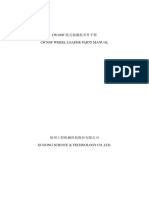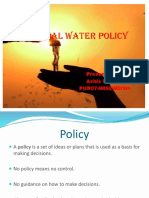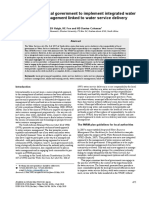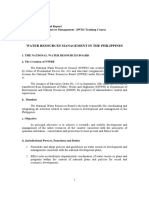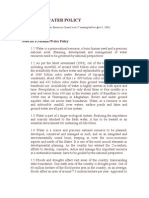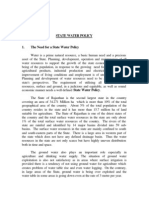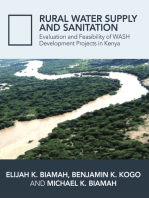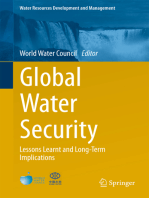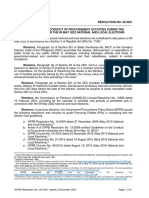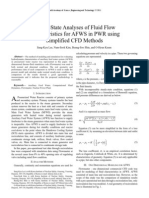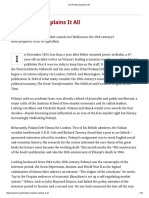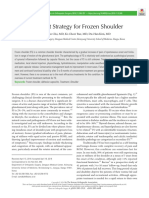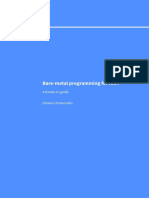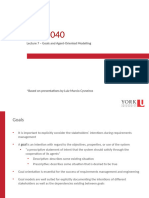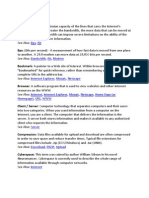WaterSanitation SAYB1516
WaterSanitation SAYB1516
Uploaded by
learneratm080Copyright:
Available Formats
WaterSanitation SAYB1516
WaterSanitation SAYB1516
Uploaded by
learneratm080Original Title
Copyright
Available Formats
Share this document
Did you find this document useful?
Is this content inappropriate?
Copyright:
Available Formats
WaterSanitation SAYB1516
WaterSanitation SAYB1516
Uploaded by
learneratm080Copyright:
Available Formats
Water and Sanitation
South Africa Yearbook 2015/16
Water and
Sanitation
South Africa Yearbook 2015/16 441
Water and Sanitation
The Department of Water and Sanitation's of water use authorisation.
(DWS) legislative mandate seeks to ensure that South Africa's Constitution and Bill of Rights
the country's water resources are protected, enshrine the basic human right to have access
managed, used, developed, conserved and to sufficient water and a safe and healthy envi-
controlled in a sustainable manner for the benefit ronment.
of all people and the environment. Government fulfils these rights through the
The DWS is mandated to develop a knowledge DWS, assisted by specific legislation:
base and implement effective policies, • The National Water Act of 1998 ensures that
procedures and integrated planning strategies South Africa's water resources are protected,
both for water resources and services. used, developed, conserved, managed and
This entails adhering to the requirements of controlled in a sustainable and equitable
water-related policies and legislation, including manner, for the benefit of all people.
constitutional requirements, that are critical in • The Water Services Act, 1997 (Act 108 of 1997),
delivering on the right of access to sufficient prescribes the legislative duty of municipalities
food and water, transforming the economy and as water-service authorities to provide water
eradicating poverty. supply and sanitation according to national
The DWS's strategic objectives are to: standards and norms. It also regulates water
• ensure efficient water usage by supporting boards as important water service providers
municipalities to implement water conser- and gives the executive authority and respon-
vation and demand management programmes sibility to the Minister of Water and Sanitation to
continuously; support and strengthen the capacity of munici-
• maintain a reliable and equitable supply palities to manage their own affairs, exercise
of water by developing new and updating their powers and perform their functions.
existing reconciliation strategies for the water • The Water Services Act of 1997 places
management areas in Richards Bay by March an obligation on the Minister to maintain a
2016, Limpopo North by March 2017, and National Water Services Information System
Mahikeng by March 2018; and to monitor the performance of all water
• generate information that is used to inform services institutions.
decisions on programmes for water • The Water Research Act, 1971 (Act 34 of
management by improving the monitoring of 1971), provides for the promotion of water-
water resources, through the development related research through a Water Research
of a hydrological water monitoring network Commission (WRC) and a Water Research
system, to enable the review of all existing Fund.
water monitoring networks by March 2017 • The National Environmental Management
• ensure the protection of water resources Act (Nema), 1998 (Act 107 of 1998), makes
by developing an integrated water quality provision for cooperative environmental
management strategy to determine resource governance by establishing principles for
quality objectives for 11 river systems by decision-making on matters affecting the
March 2018. environment, institutions that promote
cooperative governance and procedures
Legislation for coordinating environmental functions
The DWS published the draft regulations requir- exercised by organs of state.
ing that the abstraction of water for irrigation • The National Water Policy is underpinned by
purposes be limited, monitored, measured and three fundamental principles for managing
recorded for public comment. water resources: equity, (environmental)
In terms of the National Water Act, 1998 (Act sustainability and efficiency.
36 of 1998), the Minister of Water and Sanitation Sanitation provision is governed by the Strategic
must publish regulations in terms of Section 26 Framework on Water Services (2003) and the
of the Act, which requires that the abstraction of Water Services Act of 1997.
water for irrigation of crops should be limited, All water users who do not receive their
monitored, measured and recorded. water from a service provider, local authority,
The regulations limit the abstraction rate, water board, irrigation board, government water
prescribe procedures, give powers to authori- scheme or other bulk supplier, and who use
ties and define offences. These regulations are water for irrigation, mining purposes, industrial
necessary for effective monitoring and enforce- use, feedlots or in terms of general authorisation,
ment of compliance to the limits and conditions have a statutory obligation to register. This
South Africa Yearbook 2015/16 442
Water and Sanitation
includes the use of surface and groundwater. These included the security of water supply,
Other uses that must be registered include: environmental degradation, and pollution of
• diversion of rivers and streams resources.
• discharge of waste or water containing waste The NWRS2 outlines the key challenges,
• storage, which includes any person or body constraints and opportunities in water resource
storing water for any purpose from surface management and proposes new approaches
run-off, groundwater or fountain flow in excess that ensure a collective and adequate response
of 10 000 m³ or where the water area at full for the benefit of all people in South Africa.
supply level exceeds one hectare (ha) in total This strategy moves towards the achievement
on land owned or occupied by that person or and attainment of an inclusive sustainable and
body, and who is not in possession of a permit equitable economy.
or permission The NWRS2 ensures that the management
• local authorities and other bulk suppliers with of national water resources contributes towards
their own water sources and purification works achieving South Africa's growth, development
• controlled activities such as irrigating with waste, and socio-economic priorities in an equitable
power generation with water, atmospheric and sustainable manner over the next five to 10
modification or recharging of aquifers. years.
An assessment of the environmental require- The strategy also responds to the priorities set
ments of the rivers and streams concerned is by government in the National Development Plan
conducted before a licence can be issued. (NDP) and National Water Act of 1998 imperatives
To promote sustainable and equitable water that support sustainable development.
resource management, the department has It is centred on three key objectives:
developed and continues to update a range of • Water supports development and the
strategies for water management. elimination of poverty and inequality. The
strategy recognises that the manner in
Transformation which water was allocated in the past was
In pursuance of the transformation agenda, the unequal and favoured certain sections of
DWS was in mid-2016 moving towards finalising the population. The intention, therefore, is
the National Water and Sanitation Bill that to redress past imbalances in the manner in
will undergo parliamentary processes and be which water was allocated.
published for public consultation. • Water contributes to the economy and job
The objective of the Bill is to radically transform creation.
the water and sanitation sector across the value • Water is protected, used, developed, con-
chain and create an enabling environment served, managed and controlled in a
for the delivery of basic water and sanitation sustainable and equitable manner.
services to communities who were historically The NWRS2 also focuses on water conservation
disadvantaged, thus enhancing access, equity and the management of water demand as key
and sustainability. priorities.
The department will also ensure that the
establishment of the Water and Sanitation Water for Growth and Development
Infrastructure Agency finds traction whilst (WfGD)
pursuing the consolidation and rationalization The WfGD Framework points to the relationship
of the water boards to establish wall-to-wall between the availability of water and the many
water boards. The Water Use Licence regulatory forms of economic activity that depend on the
framework has been revised in accordance with available supply of water of specific levels of
the integrated licence approach. In addition, quality.
the regulations for the metering of water for The department's position is that the country's
irrigation purposes have been gazetted for public economic growth target cannot be achieved at
comments and were expected to be finalised the expense of the ecological sustainability of
during 2016. water resources or meeting people's needs.
It wishes to respond to the needs of the
Policies and strategies different economic sectors and this is best
National Water Resource Strategy achieved when water supply and the impact of
(NWRS) use are factored in during planning.
The NWRS2 sets out the vision and strategic Rather than being an add-on or afterthought,
actions for effective water management the department's position is that the need for
South Africa Yearbook 2015/16 443
Water and Sanitation
water has to be mainstreamed and placed at the National Groundwater Strategy
nucleus of all planning decisions in the public Groundwater is a strategic resource in many
and private sector. parts of South Africa, especially in rural areas.
For water to support economic growth without It also plays an important role in the supply of
compromising primary needs or ecological water to small towns and villages in the drier
sustainability requires adequate integrated parts of the country.
strategic planning. There is considerable potential for additional
Although the WfGD framework was approved development of groundwater resources to
by Cabinet, it was never gazetted. augment existing resources.
The revised NWRS2, however, has The need for improved groundwater
incorporated aspects of the WfGD that pertain management to ensure sustainable and
to water resource management as key core efficient use of the resource was recognised in
strategies. NWRS-1 and led to the formulation of a National
Groundwater Strategy through which strategic
Raw Water Pricing Strategy actions were undertaken.
There have been continued efforts to reform In 2016, the DWS issued a gazette to limit urban
and realign the water value chain so that it can water use by 15% and irrigation use by 20%.
achieve government's objectives since 1994.
These include ensuring equitable access Reuse Strategy
to water and sanitation, the sustainable use The DWS has developed a water reuse strategy
of water for social and economic benefit, and to encourage informed decisions relating to
ensuring the sustainability of water resources water reuse.
and water-services delivery. As part of this Reuse could be increased significantly with
process, the DWS is looking at pricing, financing return flows in coastal cities, where it would
and economic regulation reforms in the water otherwise drain into the sea.
sector. This project will review the raw water In coastal cities, water reuse and desalination
pricing strategy, develop infrastructure funding compete as two options for water conservation.
models and recommend an appropriate model Reuse is becoming increasingly acceptable
and institutional arrangements for an economic and feasible owing to increasing shortages,
regulator for water. improved purification technology and decreasing
It is generally agreed that pricing and economic treatment costs. Membrane technologies, also
regulation play a key role in the provisioning of used for desalination of seawater, have become
infrastructure by assuring necessary investments more affordable and have improved.
to support socio-economic growth and ensuring The reuse of treated waste water would be
that services are widely available and accessible managed to ensure public health safety.
and priced at levels that support current and
future needs. Water Bilateral Agreements
The project will contribute to the following: In February 2015, 35 Cuban water specialists
• The revision of the Raw Water Pricing Strategy arrived in the country to work in various fields
to ensure equitable and appropriate raw water of water, following an agreement between the
tariffs that will enable sustainable operation South African and Cuban governments.
and management of raw water infrastructure This followed an agreement on cooperation
and will fund catchment management in the fields of water resource management and
• Funding/financing models for water resources water supply that the two governments signed in
infrastructure Johannesburg in September 2013.
• The establishment of an economic regulator The specialists have been contracted to work
for the entire water value chain. in South Africa for two years, with the possibility
The project is strategic in nature and will enable of extending their stay by another year.
the DWS to have sound water-pricing policies, Among the recruits were:
cost-reflective tariffs for the entire water value • civil engineers
chain in South Africa and a good funding • electrical engineers
framework for infrastructure. The project is • mechanical engineers
divided into three work-streams, each to be led • irrigation and drainage specialists
by the DWS together with different institutions to • hydraulic engineers.
provide support. The recruitment of the engineers was an elaborate
process, which also involved the participation of
South Africa Yearbook 2015/16 444
Water and Sanitation
a South African organisation of engineers that resource poor farmers.
helped the department in the selection. The DWS is proceeding with the planning
The specialists work from the department's of the Mzimvubu Water Project, which entails
head office in Pretoria and in rural areas of South the development of a multipurpose dam
Africa where there are skills shortages. The (the Ntabelanga) to supply new irrigation
experts were recruited at a middle management development, and the Laleni Dam for hydropower
level. This would cost government less than generation.
R500 000 per person a year. The project will also provide domestic and
Part of the recruitment programme involves industrial water requirements in the Eastern
capacity building. The experts will train and Cape.
develop young engineers and technicians, The department has initiated the raising of
which the DWS already produces through two the Tzaneen Dam and construction of the new
learning academies at the department and Rand N'wamitwa Dam for the Groot Letaba River
Water. In terms of the agreement, the specialists Water Development Project in Limpopo. The
would work in the following areas: total estimated cost of the project is R4,2 billion
• geo-hydrology and engineering services in with a projected completion date of 2019.
rural areas and other disadvantaged areas A bilateral meeting with the Minister and the
where such services are inadequate Minister of Energy and Water Development from
• exploitation of available water resources Zambia, Dora Siliya, was held in January 2016.
• infrastructure for water supply capacity Like any country in the SADC, Zambia is also
building through training and support of local affected by drought. Water supply in urban
staff areas is intermittent, with a supply of 16 hours
• water management and its supply. a day on average. The highest intermittency
The DWS made good progress with the has been measured in the small Luapula Utility
preparatory work of the Lesotho Highlands with six hours per day.
Water Project (LHWP) which is expected to Future partnerships between the two ministries
begin in 2019. are set to develop where both ministries can
The Polihali dam, the Polihali-Katse transfer share knowledge and best practices on how
tunnel and other infrastructural aspects of the to deal with water development as a key issue.
LHWP Phase II should be completed by 2024. South Africa is keen to get water from the
Once Phase II has been completed, the amount Zambezi in the near future in order to augment
of water supplied to South Africa through the water supply to the Limpopo Region.
LHWP will progressively increase from 780 There have also been many discussions with
million cubic metres to about 1.27 billion cubic Zimbabwe at a bilateral level.
metres a year over the following 20 years. An agreement on the cooperation on water
There is progress in the Mokolo and Crocodile resources management and the establishment
River pipeline project, which will transfer water of a joint water commission was concluded with
through a 46-km pipeline and pump station from Zimbabwe on 8 April 2015.
the Mokolo Dam to the Lephalale area.
The raising of the Hazelmere Dam wall Rainwater harvesting
will incorporate a Piano Key Weir, which is The DWS supports a national rainwater
cutting-edge technology in dam building. The harvesting programme, which has a narrow but
additional water that will become available from important focus on the construction of above-
this project is aimed at ensuring the supply of and below-ground rainwater storage tanks by
water and supporting the development of human rural households for food gardens and other
settlements, King Shaka Airport and the Dube productive water uses.
Trade Port. Several municipalities now use roof rainwater
The raising of the Clanwilliam Dam will tanks for domestic purposes. These have been
commence in October 2015 at an estimated found to be particularly effective when used in
cost of R2,5 billion. The raising of the dam will conjunction with other water supply options.
also include dam safety measures to ensure the Though there are no hard figures yet on
stability of the embankment. The construction of how many cubic millimetres per year rainwater
the N7 re-alignment started in August 2014 and harvesting can contribute, it is an option that can
is scheduled for completion in March 2017. be implemented in a short timeframe.
Three quarters of the extra water that will be Rainwater harvesting enables people who
available from this project will be reserved to live in areas where reticulation has not as yet
South Africa Yearbook 2015/16 445
Water and Sanitation
been implemented to have access to water. The been allocated R6 014 764 000
programme targets rural communities through • Water services operating subsidy:
the installation of tanks and awareness creation R611 227 000
sessions. • Water services projects: R209 377 000.
Desalination strategy Role players
The department has developed a supporting Water boards
desalination strategy, which also includes desali- The primary activity of water boards is to provide
nation as a technology for treating water other water services (bulk potable and bulk waste water)
than seawater for water reuse. Desalination of to other water services institutions within their
seawater could potentially provide an unlimited respective service areas. They may perform other
resource of fresh water. However, the rising cost activities under conditions set out in the Water
of energy may be a deterrent. Services Act of 1997. In certain situations, the
As with other infrastructure projects with Minister of Water Affairs may direct water boards
potential environmental impacts, the planning to amend their business plans to meet all the
for a desalination plant will have to undergo an requirements of the Water Services Act of 1997.
environmental impact assessment in compliance There are nine water boards in South Africa.
with Nema of 1998.
The DWS will ensure that desalination is Catchment management agencies (CMAs)
considered as an option for meeting future water The main responsibilities of CMAs are to manage
requirements, in particular in coastal cities where water resources at catchment level in collabo-
there is sufficient electricity for desalination. ration with local stakeholders, with specific focus
The target is not only to implement desali- on involving local communities in the decision-
nation in several locations in South Africa, but making processes, in terms of meeting basic
also to become an international knowledge human needs, promoting equitable access
centre in this particular field. to water, and facilitating social and economic
development.
Budget and funding In essence, CMAs are service-delivery
The department transferred R2,6 billion in agencies and are listed in the Public Finance
2014/15, R3,7 billion in 2015/16 and plans Management Act, 1999 (Act 1 of 1999). There
to transfer R4 billion in 2016/17 to the Water are nine CMAs in South Africa.
Trading Entity through the Water Infrastructure Water-user associations (WUAs)
Management programmes. WUAs are cooperative associations of individual
The DWS for 2015/16 was allocated a budget water users who wish to undertake water-related
of R16 446 530 000. The breakdown of this activities at local level for their mutual benefit.
budget, for each programme, is as follows: They operate in terms of a formal constitution as
• Administration: R1 526 167 000; set out in Schedule 5 of the National Water Act
• Water planning and information management: of 1998.
R808 655 000. Examples are a feasibility study
for the uMkhomazi project and the Lusikisiki Water Research Commission
surface and ground water study; The WRC has a vital role in water research by
• Water infrastructure development: R12 435 establishing needs and priorities, stimulating
787. Examples are Mzimvubu, Clanwilliam, and funding research, promoting the transfer
Hazelmere, Vaal Gamagara, Gariep Augmen- of information and technology, and enhancing
tation and the Olifants bulk distribution system; knowledge and capacity building in the water
• Services: R1 444 582. Examples are rain sector.
water harvesting and support to resource-poor The commission provides support to the water
farmers; sector and all its relevant institutions and partners.
• Water sector regulations: R231 339 000; Over the medium term, it will focus on
Water Services Infrastructure programmes water resources management, water-linked
have also been allocated funds as follows: ecosystems, water use and waste management,
• Municipal water infrastructure grant: and water use in agriculture.
R2 595 661 000 Water is core to achieving the Department of
• Accelerated community infrastructure: Science and Technology's (DST) Global Change
R253 757 000 Grand Challenge, as well as broader national
• regional bulk infrastructure programme has targets relating to the green economy.
South Africa Yearbook 2015/16 446
Water and Sanitation
The DST and the WRC are to develop the of licences to use water. It is an independent body
roadmap to provide a 10-year platform for and can hold hearings anywhere in the country.
research, development and innovation in the The WRC and the Judicial Services Com-
water and wastewater sectors of South Africa. mission recommend people to be included as
This includes providing a platform for the members of the Water Tribunal, and the Minister
country to compete with leading countries in water of Water Affairs appoints them. The members
technology, increase the numbers of technology- have to be familiar with water management,
based small and medium-sized enterprises engineering, law and other related matters, and
operating in the water sector and increase access they are given administrative support by the DWS.
to water and sanitation in rural communities.
Strategic Water Partners Network –
Water Trading Entity (WTE) South Africa (SWPN-SA)
The DWS is responsible for the regulation of SWPN-SA is one of South Africa's most inno-
water use in South Africa by ensuring that water vative public-private civil-society sector partner-
is allocated equitably and used beneficially in the ships, making progress that would not have
public interest, and is also required to create a been possible.
register of all water users in the country. The efforts of the SWPN-SA are integral to the
The National Water Act of 1998 makes NWRS, which the DWS released in 2012.
provision for cost recovery on services rendered A cornerstone of the SWPN-SA is developing
by the department to water users. It is against innovation that leverages the strength and
this background that the department created the expertise of the DWS, the South African private
WTE within its administration. sector, civil society, and expert organisations.
The main function of the WTE is development,
operation and maintenance of specific water Resources
resources infrastructure and managing water South Africa's water resources are, in global
resources in specific water management areas. terms, scarce and extremely limited. The total
flow of all the rivers in the country is about
Trans-Caledon Tunnel Authority (TCTA) 49 200 million m3 a year. Groundwater plays a
The TCTA is a State-owned entity (SOE) pivotal role, especially in rural water supplies.
specialising in project financing, implementation The country's climate varies from desert and
and liability management. semi-desert in the west to sub-humid along the
It is responsible for the development of bulk eastern coastal area, with an average rainfall of
raw-water infrastructure. It also provides an about 450 mm per year. This is well below the
integrated treasury management and financial world average of about 860 mm per year, while
advisory service to the DWS, water boards, evaporation is comparatively high.
municipalities and other entities that are linked Water resources are unevenly spread across
to bulk raw-water infrastructure. The TCTA is South Africa. The variable rainfall distribution
primarily responsible for off-budget projects. and characteristics give rise to an uneven run-off
and distribution of water resources, with more
Komati River Basin Water Authority than 60% of the river flow arising from only 20%
The Komati Basin Water Authority was of the land area.
established in terms of a treaty between South To compensate for the uneven spread of water
Africa and Swaziland. The aim of the authority is to resources and to manage floods and droughts,
manage the water resources of the Komati River more than two-thirds of the country's mean
basin sustainably. The authority is responsible for annual run-off are stored in dams. Most of the
financing, developing, operating and maintaining economically available yield from surface water
the water resources infrastructure in the basin, resources has been fully developed and used,
comprising the Driekoppies Dam in South Africa and opportunities for developing new and there
and the Maguga Dam in Swaziland. are few economic dams.
South Africa's inland water resources include
Water Tribunal more than 20 major rivers, 165 large dams, more
The Water Tribunal was established in 1998 to than 4 000 medium and small dams on public
hear appeals against directives and decisions and private land, and hundreds of small rivers.
made by responsible authorities, CMAs or water However, owing to the predominantly hard-
management agencies about matters covered by rock nature of South Africa's geology, there are
the National Water Act of 1998, such as the issuing
South Africa Yearbook 2015/16 447
Water and Sanitation
few major groundwater aquifers that can be urban requirements constitute about 25% as the
used on a large scale. second-largest user sector. The remaining 15%
The poor spatial distribution of rainfall means is shared by the other sectors (all standardised
that the natural availability of water is also highly to 98% assurance of supply).
uneven. This is compounded by the strong The total nett abstraction of water from
seasonality of rainfall over virtually the entire surface water resources amounts to about
country, and the high within-season variability of 10 200 million m3 per year for the whole of South
rainfall and, consequently, of run-off. Africa, after allowing for the reuse of return flows.
As a result, stream flow in South Africa's rivers A further 8% is estimated to be lost through
is at relatively low levels most of the time, with evaporation from storage and conveyance along
sporadic high flows occurring – characteristics rivers, and 6% through land-use activities. As a
that limit the proportion of stream flow, which national average, about 66% of the natural river
can be relied upon to be available for use, and flow (mean annual run-off) therefore still remains
which also have implications for water-related in the country's rivers.
disasters such as floods and droughts. Southern Africa also has large hidden under-
To aggravate the situation, most urban and ground water reserves, with 12 to 15 aquifer
industrial development, as well as some dense systems, of which three are considered very
rural settlements, have been established in important for the future.
remote locations away from large watercourses. In South Africa, a substantial resource lies in
As a result, the requirements for water already a massive dolomite aquifer system that covers a
far exceed its natural availability in several vast area, extending from Springs and Brakpan,
river basins. Widespread and often large-scale east of Johannesburg to Lenasia, south of the
transfers of water across catchment areas have, city; Zuurbekom, Carltonville and Magaliesberg
therefore, been implemented. on the West Rand; Kuruman in the Northern
Provided that South Africa's water resources Cape and even as far as parts of Botswana.
are judiciously managed and wisely allocated The Witwatersrand mining basin's aquifer
and used, sufficient water of appropriate quality storage capacity is about the size of Lake Kariba.
will be available to sustain a strong economy,
high social standards and healthy aquatic Dams and water schemes
ecosystems for many generations. In an attempt to respond adequately to demand
South Africa depends mainly on surface-water and anticipate future demand, South Africa has
resources for urban, industrial and irrigation built numerous large and medium-sized dams,
water supplies in the country. In general, surface- and developed sophisticated inter-basin transfer
water resources are highly developed in many schemes. The country now has more than 500
parts of South Africa. government-owned dams countrywide. They
Groundwater is also used extensively, range in storage capacity from a volume of
particularly in the rural and more arid areas, 5 500 million m3 of water down to 0,2 million m3.
contributing to some 60% of newly serviced In April 2015, it emerged during a meeting
households since 1994. of the Presidential Infrastructure Coordinating
In the northern parts of the country both surface Commission (PICC) that there were plans to
and groundwater resources are nearly fully build, or expand on, six dams over the next
developed and used. Some overex-ploitation decade to address the long-term water and
occurs in localised areas, with little undeveloped sanitation needs of the country.
resource potential remaining. The reverse Most water consumption can be attributed to
applies to the well-watered south-eastern drinking, irrigation, electricity, mining processes
region of the country, which still has significant and industrial processes.
undeveloped and under-used resources. The DWS follows an integrated approach
The total mean annual run-off of water in South to managing South Africa's water resources.
Africa under natural (undeveloped) conditions Proposed new water schemes have to comply
is estimated at a little over 49 200 million m3 with the NWRS, requiring that water-demand
per year, including about 4 800 million m3 per management programmes be implemented
year of water originating in Lesotho, and about before embarking on new infrastructure
700 million m3 a year originating in Swaziland, development.
which naturally drain into South Africa. Strict environmental impact assessments must
Agricultural irrigation represents close to 60% also be performed in accordance with laws and
of the country's total water requirements, while regulations administered by the Department
South Africa Yearbook 2015/16 448
Water and Sanitation
of Environmental Affairs, while the guidelines Eastern Cape, Limpopo, Northern Cape, North
issued by the World Commission on Dams must West and KwaZulu-Natal.
also be followed. The lack of perennial streams in the
Bulk infrastructure is a critical element of semi-desert to desert parts means that two thirds
water-services infrastructure and an integrated of South Africa's surface area depend largely on
part of water-services management. groundwater.
Government has implemented key projects to Although irrigation is the largest user, the
augment South Africa's water resources: supply to more than 300 towns and smaller
• The TCTA has procured funding to implement settlements is very important.
the Mokolo and Crocodile River West Water Through government's commitment towards
Augmentation Project's first two phases at a meeting the basic water needs of communities,
cost of about R2 billion, to deliver water to groundwater has become a strategic resource
Eskom's new Medupi power station and other for village water supply in the wetter parts of the
industries in the area, as well as domestic country, because of its cost-effectiveness in a
water to the Lephalale Local Municipality. widely scattered small-scale user situation.
• The Bloemendal Bulk Water Project helps Groundwater also contributes considerably to
to address issues of water-borne diseases river flow. This requires reserving a significant
and water shortages in Delmas, in the Victor share of groundwater resources to protect
Khanye Local Municipality. The bulk-water aquatic ecosystems in terms of the National
project is part of the government's drive to Water Act of 1998. The maximum quantity of
bring services to the people of the country. groundwater that can be developed economically
The project is designed to supply 25 Mt/d is about 6 000 million m3 a year, while some
(potable water) and is sufficient to meet water 4 000 million m3 of groundwater (mainly in the dry
demand in the service area up to 2026. The season) contributes to surface-water flow annually.
new project incorporates a 10 Ml reservoir
located at mid-point of the new pipeline and is Managing and developing water
designed to improve system operation as well. resources
• The Spring Grove Dam in Mooi River, To facilitate the management of water resources,
KwaZulu-Natal, supplies water to the the country has been divided into 19 catchment-
eThekwini Metropolitan Municipality and the based water management areas, of which 11
uMgungundlovu District, Msunduzi Local, share international rivers.
Ugu Local, Sisonke and iLembe local munici- Sufficient water resources have been deve-
palities. loped and are available to ensure that all
requirements for water can reasonably be
Groundwater resources met, without impairing the socio-economic
An estimated 80 000 to 100 000 boreholes development of the country.
are being drilled annually. The data generated Where feasible, special management tech-
through the drilling of this amount of boreholes niques may be applied to improve water quality
can enhance the knowledge of the occurrences to appropriate standards for particular uses.
and utilisation of groundwater tremendously The quality of groundwater varies according to
and thus it is imperative to get the data onto hydrogeological conditions and anthropogenic
the Department databases. At the same time it impact. However, most major aquifer systems
will enhance the Department's ability to execute contain potable-quality water.
its mandate to protect, manage and control the To underscore its commitment to the pursuit of
groundwater resources of the country. universal access to water, the DWS is investing
An international search has shown that in new infrastructure and maintaining and
it is common practice to register drilling rehabilitating dysfunctional systems to ensure
contractors thus the Department has launched operational efficiency.
a project to investigate the mechanisms for This is particularly relevant to developing
successful registration processes as well as water infrastructure to meet the specific needs
possible training and controlling mechanisms. of different rural communities. Closely related to
Groundwater, despite its relatively small contri- rural development is the need for mainstream
bution to bulk-water supply, represents an support to local government to sustain the
important and strategic water resource in South infrastructure underpinning efficient service
Africa, since it services between 52% and 82% delivery to communities.
of community water-supply schemes in the
South Africa Yearbook 2015/16 449
Water and Sanitation
Managing water quality and wastewater case basis in accordance with legislation in order
To ensure compliance with minimum water quality to safeguard the well-being of communities.
norms and standards, the DWS started the In partnership with the Eastern Cape and
annual Blue Drop and Green Drop assessments North West provincial governments respectively,
to guarantee that water and wastewater systems the DWS intervened in municipalities which
are managed according to set norms and have been placed under administration. These
standards. include the Makana Local Municipality in the
The department has set a target of 99% Eastern Cape, the Madibeng Local Municipality,
compliance with drinking-water quality standards and Ngaka Modiri Molema District Municipality
and 80% compliance with wastewater effluent in North West.
standards. An important element of these interventions
This incentive-based regulation system aims has been the successful use of the Water
to improve the quality of municipal drinking water Boards of Amatola, Magalies, and Sedibeng,
quality and management of waste water. respectively, to supplement the capacity of the
Because of the scale and magnitude of department to improve operational performance
resources needed for the national certification and build new infrastructure where necessary.
programme, the Green Drop and Blue Drop In Limpopo, the DWS has appointed the
programmes take place every second year, Lepelle Northern Water as an Implementing
alternating with each other. In a programme's Agent for the Mopani District Municipality
“gap” year, progress in the wastewater sector Revitalisation Programme, which includes
is tracked and reported via the assessment various water treatment works, waste water
of the cumulative risk status of treatment treatment works, boreholes and pipelines.
systems. In Bushbuckridge, Mpumalanga, through
The department was honoured to receive Rand Water, the DWS executed an emergency
international recognition in terms of Environ- intervention to solve operational problems
mental Engineering Excellence for the Blue which were causing water shortages and also
Drop and Green Drop Certification programmes accelerating the implementation of water reticu-
from the American Academy for Environmental lation infrastructure.
Engineers. This academy is affiliated to the In each of the identified municipalities,
International Water Association. qualified and experienced personnel are being
deployed to work on, and implement, a Road
Programmes and initiatives Map for a “Water Secure and Safe Sanitation
Integrated Water Resources Future” using budgets pooled from national and
Management (IWRM) provincial governments and from the affected
The DWS, with the assistance of the Royal municipalities.
Danish Government, initiated a programme in
2000 to pilot IWRM approaches in three water The Water and Sanitation Revolution
management areas of South Africa: Crocodile The key strategic priorities for the water and
West – Marico (mainly in North West), Mvoti to sanitation revolution are:
uMzimkulu (KwaZulu-Natal) and Olifants-Doorn • water resource management
(mainly in the Western Cape). • water infrastructure development
These water management areas were • water and aanitation services
selected as they represent a cross-section of • policy regulation.
water resources conditions as well as water-use The key pillars of this revolution are:
conditions and user interests. • water conservation and demand management
The IWRM requires intensive planning to that involves the use of innovation and
ensure efficient, equitable and sustainable regulation to reclaim water already developed
management of water resources and for coping and available for use.
with conflicting demands. • improving the water mix involves the increased
use of a variety of water sources in addition to
Back to Basics Programme our current reliance on surface water
Whilst the Back to Basics Programme is focused
on 27 district municipalities, the PICC has given Brits Water Treatment Works
the department the task to intervene when there The DWS, working together with the Madibeng
are problems. Local Municipality, set aside R381 million to
These interventions shall be on a case-by- address water challenges in Majakaneng through
South Africa Yearbook 2015/16 450
Water and Sanitation
the upgrade of the Brits Water Treatment Works Municipality in North West.
(BWTW) which also supplies the Majakaneng Upon completion, the project will address water
area. shortages in the villages of Kwa-Mmatlwaela,
The works will ensure that the BWTW has an Tladistad, Leeukraal, Kgomo-Kgomo, Kontante,
additional production capacity of 20Ml/d. Work is Moretele, Makapanstad, Phomolong, Potoane,
underway at the BWTW with civil works (Phase Prieska, Mathibestad, Thulwe and Opperman.
1). It will be implemented by a DWS Construction The Mathibestad and Makapanstad Bulk
Unit as contractors and two professional service Water Project is funded through the Provincial
providers have been appointed for electrical and Infrastructure Grant and Municipal Infrastructure
mechanical works. Grant.
The BWTW is expected to be completed by
2017/18. Strategic Integrated Projects (SIPs)
In the short-term, DWS allocated R1,1 million SIP 18, which was approved by the PICC, aims
to the Madibeng local municipality to address to address water supply and sanitation backlogs
the water challenges in Majakaneng, which are to millions of households.
mainly attributed to vandalism and leakages in The PICC's 18 SIPs are divided into geographic,
the water supply system. energy, spatial and social infrastructure
The Madibeng Local Municipality embarked development projects. These projects – headed
on leak detection exercises and filling the by different departments – cover more than 150
reservoirs. The municipality commenced with specific infrastructure interventions in rail, road
distribution of water to identify and repair visible and ports, dams, irrigation systems, sanitation
leaks. This required isolation of certain sections and electricity.
of Majakaneng and it was expected that not all This programme is a 10-year plan that will
sections would water. address the estimated backlog of adequate
The DWS and Madibeng Local Municipality water to 1.4 million households and that of basic
will continue cooperating to deal with the water sanitation to 2.1 million households.
leakages, which cause low water pressure in SIP 18 is expected to fast-track the issuing of
Majakaneng and, as a result, water shortages in water licences, expand the capacity of the water
some areas. system, speed up build programmes, address
backlog projects and rehabilitate and upgrade
existing water and sanitation infrastructure.
National Water Resources The project, which will also focus on priority
Infrastructure (NWRI) Programme small towns and rural areas where water service
The NWRI ensures reliable supply of water delivery is a problem, is also expected to create
from bulk raw-water resources infrastructure. jobs, raise the quality of service delivery of water
The programme sources funding to implement, around the country and extend water supply to
operate and maintain bulk raw-water resources areas that are either underserviced or unserviced.
infrastructure efficiently and effectively by The department identified several projects
strategically managing risks and assets. that will be used to drive SIP 18, including the
Sedibeng Regional Sewer Scheme which is a
Regional Bulk Infrastructure Grant R5-billion project to be implemented in the area.
Programme Rand Water's BG3 pipeline, which is
Regional bulk infrastructure is defined as sub-Saharan Africa's largest water pipeline,
the infrastructure required to connect water running from the Vaal Dam to its Zoekfontein
on a macro or sub-regional scale, over vast Plant, which is 8,6 km away, was launched in
distances, with internal bulk and reticulation June 2013.
systems or any bulk infrastructure that may The pipeline will increase water distribution in
have an impact on water resources in terms this district and surrounding areas.
of quality and quantity. The department The BG3 pipeline runs adjacent to Rand
is responsible and accountable for the Water's existing BG1 and BG2 pipelines that
management of funding, which is administered supply water to Gauteng and parts of the
by the National Treasury. neighbouring Free State, Mpumalanga and
Over 16 000 households will benefit from the North West.
R52 million Makapanstad and Mathibestad Bulk Once in commission, the BG3 pipeline will
Water Project, which aims to address water allow for Rand Water's two pipelines (BG1 and
shortages in villages in the Moretele Local BG2) to be shut down for refurbishment and
South Africa Yearbook 2015/16 451
Water and Sanitation
maintenance. The BG3 pipeline will augment Water Allocation Reform
raw-water capacity to Zuikerbosch by up to The Water Allocation Reform Programme's
2100 Mt/d, which will accommodate the region's objectives are to ensure equitable access to
projected growth in water demand to 2030. water, eradicate poverty and promote social
The Komati Water Scheme Augmentation and economical development. The programme's
Project (KWSAP) was designed to resolve the priorities are to meet the water needs of histor-
water supply problems to Eskom's Duvha and ically disadvantaged people, ensure their partici-
Matla power stations in Mpumalanga. pation in water resources management and
The KWSAP augments the Komati Water promote the beneficial and efficient use of water
Scheme from the Vaal Eastern Subsystem in the public interest.
to help Eskom overcome its water supply Licences are required for storage and use
challenges. The Matla power station reservoir of water, among other things. To facilitate the
will in turn also provide water to Kusile power availability of water for historically disadvantaged
station, which is under construction. people, attention is also given to the allocation of
The interaction of the water resources of the water following principles of equity and sustain-
Komati, Usutu and Vaal River systems provides ability.
a higher assurance of water supply to all Eskom's
thermal power stations and other water users Youth Water and Sanitation Summit
in Mpumalanga. The KWSAP will be able to The DWS ended the celebration of Youth Month
deliver an additional 57 million m3 of water a year by hosting the annual Water and Sanitation
to the Komati Water Scheme. On the depart- Youth Summit at Birchwood, Boksburg, from
ment's instruction, the TCTA is financing and the 29 June to 2 July 2015. The week-long
implementing the project which is part of SIP 18. event concluded with an award ceremony where
Limpopo was officially crowned the winner of the
Dam Safety Rehabilitation Programme 2015 South African Youth Water Prize (SAYWP).
The Dam Safety Rehabilitation Programme Learners from Shikwambana Village in
ensures the continued structural and operational Mopani District, Limpopo were inspired by the
safety of the dams owned by the DWS. continuous water pipe bursts in their village and
In April 2016 the DWS highlighted the put together a water conservation project.
developments made in the Dam Safety Rehabili- They won bursaries for tertiary education at
tation Programme: universities of their choice to study for careers in
• a cumulative 135 of the planned 138 planned the water sector. They also all received laptops
catalytic projects and dams were branded and tickets to Stockholm, Sweden, to compete
• the pipelines and electrical installations were for the Stockholm Junior Water Prize.
finalised for the short-term acid mine drainage
mitigation measures in the Eastern Basin Women in Water
• the provincial Regional Bulk Water and The Women in Water Project aims to strengthen
Sanitation Infrastructure Master Plan for the the active participation of rural women in water
Eastern Cape had been developed resource management. Women identify water-
• more than 500 resourceless farmers where related challenges in their communities and
financially supported to enhance access to conceptualise ideas to address them. They are
water. A total of 420 rainwater harvesting tanks registered for Women in Water awards. The
were installed. national winners receive cash prizes which
are used for further project development and
Support for resource-poor farmers implementation.
In accordance with the National Water Act of
1998, and regulations on financial assistance Learning Academy
to resource-poor farmers, the Minister may The DWS was swamped by requests from
allocate assistance to those farmers who fulfil ambitious, determined and young qualified
requirements. engineers who wanted to work for the water sector
To ensure that water resources are protected, and be part of efforts to enhance the quality of the
the regulations explicitly state that financial resource delivered to the needy citizens.
assistance may be granted and used only for One of the main areas in DWS that has a dire
activities that ensure water is protected, used, shortage of skills and expertise is the engineering
developed, conserved and managed in a function. The academy has made huge strides in
sustainable and equitable manner. attracting young engineers to the department.
South Africa Yearbook 2015/16 452
Water and Sanitation
To boost the programme, 20 newly qualified Council of South Africa in line with the
engineers joined the Learning Academy (LA) in Occupations Specific Dispensation.
January 2015. They completed the Department of
Public Service and Administration's compulsory Management of water conservation and
induction programme. They received training demand
at the DWS Roodeplaat Training Centre, and Although South Africa has been classified
reported for duty at their various base stations as a water-scarce country, water from the
from 2 February 2015. source to the consumer is often lost as a
The function of DWS is of great strategic result of inappropriate and inadequate asset
importance to the South African society. The management.
level of productivity within DWS and the water Lack of education on the part of the consumer
sector as a whole has a direct effect on the also leads to inefficiency in the day-to-day use of
South African economy. water. The loss of water depletes the country's
The LA is an internal structure, which was resources and reduces revenue to water
initiated in 2007 as a response to a shortage of services authorities.
specific skills needed to boost the production of The municipalities' revenue is lost due to
the department (and that of the water sector in leaking pipes, illegal connections and poor
general) through its technical and scarce- skills billing systems.
development programme. In terms of the water-use efficiency pro-
This technical structure represents an gramme, 68 municipalities were supported in
investment for sustaining the quality of DWS implementing water conservation and water
human resources, raising the level of technical demand measures to reduce water loss by
and scarce skills and thereby ensuring that, in the 519 million m³. Measures to improve efficient
long term, the department remains competitive water use in the catchment areas were also
as it delivers on its mandate. undertaken and the volume of water loss was
The LA is designed to meet specific organi- reduced to 32 million m³.
sational requirements and lead a sustained Water leaks account for nearly 36% of the
campaign to secure a steady supply of high-level nation’s unaccounted for water and costs the
skills in water-related science, engineering, and country about R7 billion annually.
various technical disciplines. Realising that South Africa is a water scarce
The LA supports the academic development country, the DWS is also putting in place medium
component through bursaries and experi- to long term interventions that are intended to
ential training. The professional development reduce the risks for water scarcity in the future.
component forms part of DWS's social respon- These include:
sibility in that it incubates young and inexpe- • Rain water harvesting (drinking water, water
rienced graduates, offering them an opportunity for livestock, water for irrigation);
to receive on-the-job training and exposure in • Integrating groundwater and surface water
their areas of study, while introducing them to use in the future;
the DWS's core business. • Desalination at a large scale;
The purpose of the LA is to: • Invest in innovative water saving solutions,
• investigate technical and scarce skills dev– such as the Drop-the-Block campaign;
elopment needs within the department • Incorporating all municipal and privately
• address technical and scarce skills gaps in the owned dams into the management system or
overall water supply value chain the future;
• address scarce skills gaps in specific technical • Implementing further transfer schemes to
areas of the department improve drought resilience;
• plan and build capacity for medium and • Building additional storage capacity;
long-term needs of the department and the • Rolling out large scale re-use of water
water and sanitation sector (recycling of effluent, focus on coastal towns
• develop and implement structured training for where treated effluent is disposed of via sea
engineering and scientific graduate trainees
• develop and propose interventions (regarding The Department of Water and Sanitation is creating Catch-
mentoring, skills and knowledge transfer, and
professional registration processes) with the
ECSA, the South African Council for Natural
and Scientific Professions and the Surveying
i ment Management Agencies to realign the previous water-
user associations. A partnership, named the Kingfisher
Programme, was formed between South Africa and the
Netherlands.
South Africa Yearbook 2015/16 453
Water and Sanitation
outfalls and not taken into account in return the mountains of the Western Cape and five
flows). in the Mpumalanga escarpment. Observations
are relayed through the cellular short-message
Enhanced Local Government Support system.
Approach Water levels are monitored at some 1 000
A rapid response unit in the department observation boreholes across South Africa.
addresses poor performance of water and Particular attention is given to monitoring in
waste-water systems, which has resulted in dolomitic areas. In addition, a small network of
community protests in some cases. rain gauges monitors rainwater quality.
The unit deals with proactive and reactive The importance of qualitative information on
non-compliance cases of municipal service South Africa's water resources has led to an
delivery. The unit's specialists enable the increasing drive towards creating a national
department to intervene directly in high-risk water-quality monitoring network.
operational situations, where the lives of citizens The formal protection, restoration and
and the environment are under threat because rehabilitation of wetlands is strengthened
of water and wastewater treatment failures. through improved land-use planning, land and
development management policies, as well as
Freshwater Programme operational and regulatory means at national,
Recognising the value and threatened status of provincial and local level.
South Africa's freshwater biodiversity, and the Adopting of ecosystem-based approaches
need to build competence and leadership in this and implementing the open-space planning and
area, the South African National Biodiversity management programmes adds impetus to the
Institute (SANBI) has established a programme protection of these systems and associated
focusing on freshwater biodiversity. services, especially at local government level.
The Freshwater Programme aims to grow and It requires integrated approaches and the
consolidate freshwater activities within SANBI. involvement of multiple sectors, particularly those
The Freshwater Programme focuses on dealing with human settlements, development
supporting collaborative freshwater initiatives. and planning.
These include Working for Wetlands, the The DWS is also designing programmes to
National Wetland Inventory, National Freshwater assess and report on the radiological (radioac-
Ecosystems Priority Areas Project, a wetlands tivity) and toxiclogical quality status of the
mitigation banking scheme with the Grasslands country's water resources.
Programme and coal-mining industry, and
water-related payments for ecosystem services National Chemical Monitoring
pilot projects. Programme (NCMP)
Key to the programme's operation will be the The NCMP assesses and reports on the chemical
further development of strategic relationships status of water resources in South Africa. The
with other organisations with shared objectives. main water-quality challenges for domestic water
This includes managing the Working users are high levels of dissolved salts and, in
for Wetlands Programme on behalf of the some places, high fluoride concentration. The
departments of water and sanitation, environ- other challenges facing irrigated agriculture are
mental affairs and agriculture, forestry and the high sodium-absorption ratio, high electrical
fisheries. Working for Wetlands champions the conductivity, high pH and high levels of chloride.
protection, rehabilitation and sustainable use Another global challenge affecting South Africa is
of South Africa's wetlands through cooperative eutrophication or excessive plant (including algae)
governance and partnerships. growth in dams. This is because of high levels of
nutrient input from point sources of pollution and
Monitoring programmes diffuse sources of pollution from catchments.
River flow is monitored at 1 200 flow-gauging Annual reports indicate that 50% of
stations and some 260 major reservoirs. The dams in South Africa are seriously affected
evaporation and rainfall station network has 360 (hypertrophic), while the rest range in quality
stations. from good (oligotrophic) to poor (mesotrophic).
The oldest flow-gauging station still operating Another problem is the sporadic outbreak
in South Africa is on the Mooi River near Potchef- of cholera and other water-borne diseases,
stroom in North West. mainly because of poor sanitation and hygiene
There are 21 operational rainfall stations in at household level. The Eastern Cape and
South Africa Yearbook 2015/16 454
Water and Sanitation
KwaZulu-Natal are prone to cholera outbreaks. South Africa.
The campaign seeks to continue building
River Eco-status Monitoring Programme on the ongoing awareness creation within the
(REMP) broader South African community.
The REMP evolved from the River Health This awareness creation is coupled with the
Programme (RHP). It replaced the RHP in 2016 responsibility that every citizen must take in
and is a component of the National Aquatic ensuring the integrity of South Africa's water
Ecosystem Health Monitoring Programme resources and its efficient use.
(NAEHMP). The linkages between water services, supply,
The REMP focuses on the monitoring of the resource management, poverty eradication,
ecological conditions in river ecosystems as they social and economic development were
are reflected by the system drivers and biological emphasised in a number of innovative ways.
responses (instream and riparian). The campaign is influenced by local needs and
international sectoral trends.
National Aquatic Ecosystem Health In 2015, National Water Week was launched
Monitoring Programme in the drought-stricken KwaDukuza in KwaZulu-
The NAEHMP is a national programme managed Natal on 16 March 2015 under the theme
by Resource Quality Services with support from “Water Has No Substitute”. This national week
the Water Research Commission, CSIR and concluded on World Water Day on 22 March
various regional and provincial authorities. 2015.
It is responsible for managing aquatic
ecosystems. It focuses on the biological Regional and international cooperation and
initiatives
attributes of a river that serve as indicators of
In line with our regional and international respon-
its ecological health. The NAEHMP's main
sibilities in the water sector, DWS entered into
objectives are to:
collaborative relationships with countries such
• generate a national perspective of the health
as: Lesotho, Namibia, Botswana, Zimbabwe,
of aquatic ecosystems in South Africa
DRC, Swaziland in the region.
• develop the capacity and information base
• Mozambique and Swaziland on the Inkomati
required to enable the department and other
and Maputo rivers
role players to report on the status of and
• Botswana, Lesotho and Namibia on the
trends in the ecological health of South Africa's
establishment of the Orange Senqu River
river systems, in an objective and scientifically
Commission
sound manner
• Botswana, Zimbabwe and Mozambique on the
• generate information products and audit-
establishment of the Limpopo Watercourse
management strategies that could assist in
Commission
distinguishing between aquatic ecosystems
• Lesotho on the Lesotho Highlands Water
exposed to sustainable use and those experi-
Project
encing ecological deterioration.
• Swaziland on the Komati River Development
National Toxicity Monitoring Programme Project.
The National Toxicity Monitoring Programme These agreements improve South Africa's
reports on the status of dichloro-diphenyl-trichlo- bilateral and multilateral relations in the African
roethane and other persistent organic pollutants. Union. All the countries involved benefit, while
This information is reported internationally to the sharing development costs.
Stockholm Convention through the Department South Africa shares four of its major river sys-
of Environmental Affairs. tems with six immediate neighbouring countries,
namely Botswana, Lesotho, Mozambique,
Education and awareness Namibia, Swaziland and Zimbabwe.
Youth development and National Water In the area of shared river basins, South
Week Africa continued participating in joint water
The National Water Week is an awareness week commissions to form part of Africa bilaterals
campaign by the DWS. It serves as a powerful with Botswana on Joint Permanent Cooperation
campaign mechanism re-iterating the value of and with Mozambique regarding the breach of
water, the need for sustainable management of the Usuthu River, where a feasibility study was
this scarce resource and the role water plays in completed.
eradicating poverty and under-development in South Africa also formed global relations with
South Africa Yearbook 2015/16 455
Water and Sanitation
countries such as Iran, China, Denmark, Russia,
Mexico, South Korea, Australia, Germany, the
Netherlands and Japan.
South Africa Yearbook 2015/16 456
You might also like
- XCMG LW300FDocument127 pagesXCMG LW300Froadparts80% (10)
- Global Textile and Apparel Sector Trend Report - The Road To 2025Document30 pagesGlobal Textile and Apparel Sector Trend Report - The Road To 2025varunvaid6636100% (1)
- DP Ops ManualDocument85 pagesDP Ops ManualTuhin Handa100% (2)
- IC Simple Cost-Benefit AnalysisDocument8 pagesIC Simple Cost-Benefit AnalysisZairah Ann BorjaNo ratings yet
- 1 Integrated Water Resource ManagementDocument16 pages1 Integrated Water Resource ManagementStukineNo ratings yet
- Approved Policy Position Document - 31-01-2014 TRDocument26 pagesApproved Policy Position Document - 31-01-2014 TRColley MatheNo ratings yet
- National Water PolicyDocument15 pagesNational Water PolicyBonzibit ZibitNo ratings yet
- National Water Policy GhanaDocument15 pagesNational Water Policy GhanaBonzibit ZibitNo ratings yet
- Slide 2 - Status of WRM in UgandaDocument25 pagesSlide 2 - Status of WRM in Ugandalawrencereagan4No ratings yet
- Kurukshetra: Water and SanitationDocument26 pagesKurukshetra: Water and SanitationPiyush OjhaNo ratings yet
- Andhra Pradesh State Water PolicyDocument17 pagesAndhra Pradesh State Water PolicygangarajuNo ratings yet
- Vaibhav - 20234Document19 pagesVaibhav - 20234Vaibhav SahuNo ratings yet
- GW CaviteDocument6 pagesGW CaviteAnn De VeraNo ratings yet
- Lecture 7 - Regulatory and Environmental IssuesDocument13 pagesLecture 7 - Regulatory and Environmental Issuescanoza.joshuaNo ratings yet
- Second Sudan Consortium March 2007: Water Supply and Sanitation Service Delivery and Challenges in Southern SudanDocument12 pagesSecond Sudan Consortium March 2007: Water Supply and Sanitation Service Delivery and Challenges in Southern SudanPedrito Aquino NudaloNo ratings yet
- National Water Policy: A Ray of Hope For A Water-Scarce PakistanDocument7 pagesNational Water Policy: A Ray of Hope For A Water-Scarce Pakistantooota_taraNo ratings yet
- National Water PolicyDocument16 pagesNational Water Policymahesh bhattarai75% (4)
- Hydrologytamalika 21Document18 pagesHydrologytamalika 21Ruhi BasumataNo ratings yet
- Full Paper Hamanth KasanDocument20 pagesFull Paper Hamanth KasanAdriana Pienaru0% (1)
- Agencies and Constitutional Provision For Water ResourcesDocument5 pagesAgencies and Constitutional Provision For Water ResourcesEmmanuela CadisimNo ratings yet
- Chris Yerima 004Document18 pagesChris Yerima 004Sikiru TiamiyuNo ratings yet
- National Water Policy: Central Water Commission, New DelhiDocument12 pagesNational Water Policy: Central Water Commission, New DelhikamakshiNo ratings yet
- Draft National Water Policy 2012Document4 pagesDraft National Water Policy 2012Shaji MullookkaaranNo ratings yet
- Framework For Local Government To Implement Integrated Water Resource Management Linked To Water Service DeliveryDocument12 pagesFramework For Local Government To Implement Integrated Water Resource Management Linked To Water Service DeliveryChanel el hifnawyNo ratings yet
- Republic Act 9275 Softcopy Group3Document7 pagesRepublic Act 9275 Softcopy Group3Melody SaipenNo ratings yet
- Draft Executive Order On The Creation of The NWMCDocument9 pagesDraft Executive Order On The Creation of The NWMCpaomillan0423No ratings yet
- Water Resources Management in The PhilippinesDocument9 pagesWater Resources Management in The PhilippinesDaryl RemNo ratings yet
- Water Quality MonitoringDocument35 pagesWater Quality MonitoringMadhavi TendleNo ratings yet
- Water Sanitation and ConservationDocument20 pagesWater Sanitation and ConservationJasmine Erica Certeza100% (4)
- NWP 20025617515534Document10 pagesNWP 20025617515534pradipkbNo ratings yet
- Public Health Engineering Division Department of Public Health Ministry of HealthDocument3 pagesPublic Health Engineering Division Department of Public Health Ministry of HealthBryan ScofieldNo ratings yet
- NewItem 116 Guidelinesof Waterqualitymonitoring 31.07.08Document35 pagesNewItem 116 Guidelinesof Waterqualitymonitoring 31.07.08adityahongkongNo ratings yet
- Ethiopian Water Sector Strategy: The Federal Democratic Republic of EthiopiaDocument37 pagesEthiopian Water Sector Strategy: The Federal Democratic Republic of Ethiopiayared sitotawNo ratings yet
- CIVWARE Lecture Topic 1 (Introduction To Water Resources Engineering)Document46 pagesCIVWARE Lecture Topic 1 (Introduction To Water Resources Engineering)Troy DanielsNo ratings yet
- Zimbabwe Report - Chapter 7Document50 pagesZimbabwe Report - Chapter 7Nik SibandaNo ratings yet
- Maharastra SWP & NWP 14.8.2019Document17 pagesMaharastra SWP & NWP 14.8.2019AnkitaNo ratings yet
- Ra 9275 Clean Water ActDocument20 pagesRa 9275 Clean Water Actleyrie100% (1)
- Philippine Clean Water ActDocument91 pagesPhilippine Clean Water Actfirmo minoNo ratings yet
- RA 9275 The Clean Water Act of 2004 GASPANDocument31 pagesRA 9275 The Clean Water Act of 2004 GASPANCyril Kaye Dolorzo100% (1)
- Philippine Clean Water Act (CWA) of 2004Document20 pagesPhilippine Clean Water Act (CWA) of 2004ROLAND JOIE GELINo ratings yet
- No Drop Report 2023Document83 pagesNo Drop Report 2023Thembela MsutuNo ratings yet
- National Drinking Water PolicyDocument11 pagesNational Drinking Water PolicySahan Chanchana Perumpuli ArachchiNo ratings yet
- Puerto Princesa City Iwrm Swot Analysis PDFDocument11 pagesPuerto Princesa City Iwrm Swot Analysis PDFmaizeeeNo ratings yet
- New TORDocument14 pagesNew TORDavid SabaflyNo ratings yet
- Water Resources Assignment 1Document5 pagesWater Resources Assignment 1mateojullieanneNo ratings yet
- Our Mission: Philippines' Department of Environment and Natural ResourcesDocument5 pagesOur Mission: Philippines' Department of Environment and Natural ResourcesAnthony Mark DulayNo ratings yet
- The Philippine Clean Water Act - RA 9275Document3 pagesThe Philippine Clean Water Act - RA 9275Kathleen Kaye CastilloNo ratings yet
- Policy, Strategy and GTP For RWaSH (Alemayehu)Document30 pagesPolicy, Strategy and GTP For RWaSH (Alemayehu)teferatamene21No ratings yet
- Local Waterworks and Utilities Administration (LWUA)Document11 pagesLocal Waterworks and Utilities Administration (LWUA)Claire Maurice JuaneroNo ratings yet
- National Water Policy 1987Document16 pagesNational Water Policy 1987haritbalaNo ratings yet
- W4L1Document64 pagesW4L1Pratham PatelNo ratings yet
- Buitems Quetta : (Environmental Management System)Document7 pagesBuitems Quetta : (Environmental Management System)Shah MehboobNo ratings yet
- Salient Features of Revised Draft National Water PolicyDocument1 pageSalient Features of Revised Draft National Water Policyashwani_scribdNo ratings yet
- Ep ReportDocument4 pagesEp ReportMalik AwanNo ratings yet
- Water Resource Management Notes For MNNITDocument6 pagesWater Resource Management Notes For MNNITParth NakhaleNo ratings yet
- Water PolicyDocument14 pagesWater Policyarvendra9788No ratings yet
- Policy, Strategy and GTP For R&U WaSH (Alemayehu)Document36 pagesPolicy, Strategy and GTP For R&U WaSH (Alemayehu)teferatamene21No ratings yet
- What You Should Know About The Clean Water ActDocument4 pagesWhat You Should Know About The Clean Water ActJazzel Avila ParadiseNo ratings yet
- G M P W R D, S W P, 2003: (1) Necessity of State Water PolicyDocument4 pagesG M P W R D, S W P, 2003: (1) Necessity of State Water PolicyMahesh MuraleedharanNo ratings yet
- Ra 9275Document6 pagesRa 9275manongsongmarinelNo ratings yet
- Pictorial Presentation of WASH Activities in Rural KenyaFrom EverandPictorial Presentation of WASH Activities in Rural KenyaRating: 5 out of 5 stars5/5 (1)
- Rural Water Supply and Sanitation: Evaluation and Feasibility of WASH Development Projects in KenyaFrom EverandRural Water Supply and Sanitation: Evaluation and Feasibility of WASH Development Projects in KenyaNo ratings yet
- Technological Trends in Water Sector for a Sustainable SolutionFrom EverandTechnological Trends in Water Sector for a Sustainable SolutionNo ratings yet
- Global Water Security: Lessons Learnt and Long-Term ImplicationsFrom EverandGlobal Water Security: Lessons Learnt and Long-Term ImplicationsWorld Water CouncilNo ratings yet
- GPPB Resolution No. 20-2021Document6 pagesGPPB Resolution No. 20-2021Roberto OberoNo ratings yet
- Exp 5Document9 pagesExp 5Cherry Charan TejNo ratings yet
- Module 5Document158 pagesModule 5Ashritha SureshNo ratings yet
- 50 Tips For Your Statement of WorkDocument4 pages50 Tips For Your Statement of WorkRandy ZarateNo ratings yet
- Ayur Herbals-AshishDocument44 pagesAyur Herbals-Ashishsharmagoel100% (1)
- (PONTIAC) Manual de Taller Armado y Desarmado Motor Pontiac Aztek 2001 Ingles PDFDocument34 pages(PONTIAC) Manual de Taller Armado y Desarmado Motor Pontiac Aztek 2001 Ingles PDFtrastornadojhonNo ratings yet
- Lifecell PPT 2011Document30 pagesLifecell PPT 2011Prabhakar KumarNo ratings yet
- Telangana State Policies (English)Document29 pagesTelangana State Policies (English)deepakk047No ratings yet
- PlacidoDomingo RiderDocument20 pagesPlacidoDomingo RiderTaraNo ratings yet
- Greed IS Back: Business With PersonalityDocument36 pagesGreed IS Back: Business With PersonalityCity A.M.No ratings yet
- Steady-State Analyses of Fluid Flow Characteristics For AFWS in PWR Using Simplified CFD MethodsDocument4 pagesSteady-State Analyses of Fluid Flow Characteristics For AFWS in PWR Using Simplified CFD MethodsViswanathan DamodaranNo ratings yet
- Karl Polanyi Explains It AllDocument13 pagesKarl Polanyi Explains It AllThiên Phi TôNo ratings yet
- Treatment Strategy For Frozen ShoulderDocument9 pagesTreatment Strategy For Frozen ShoulderDiah Rindayani HasbiNo ratings yet
- Costing Analyst NestleDocument2 pagesCosting Analyst NestleJulian LerigetNo ratings yet
- Arm Baremetal EbookDocument96 pagesArm Baremetal EbookFlavio FalcãoNo ratings yet
- Manual Utilizare K600Document56 pagesManual Utilizare K600Nicole TuricianuNo ratings yet
- 1248 - 5 Analouge Electrical Measuring Instrument - Spl. Req. FDocument8 pages1248 - 5 Analouge Electrical Measuring Instrument - Spl. Req. Frpaliwal1967No ratings yet
- BÀI KIỂM TRA 1 TIẾT SỐ 1.doc anh 7 de 2Document2 pagesBÀI KIỂM TRA 1 TIẾT SỐ 1.doc anh 7 de 2ton anh daoNo ratings yet
- Public Administration Unit-98 Administrative Problems of Public SectorDocument11 pagesPublic Administration Unit-98 Administrative Problems of Public SectorDeepika SharmaNo ratings yet
- Price List KJ September2022 - CDocument1 pagePrice List KJ September2022 - CDidit Pringadi PutraNo ratings yet
- ITEC 4040A_Lecture 7 - Goals and AgentsDocument64 pagesITEC 4040A_Lecture 7 - Goals and AgentsjiholambertiNo ratings yet
- Brochure 1Document20 pagesBrochure 1련서긔No ratings yet
- Internet TerminologiesDocument7 pagesInternet TerminologiesGeorge AsareNo ratings yet
- Arf105 ManualDocument12 pagesArf105 ManualqqqNo ratings yet
- Gafta Qualified Arbitrator StatusDocument1 pageGafta Qualified Arbitrator StatusBrandonNo ratings yet
- Retainer ContractDocument2 pagesRetainer ContractIjhong Formoso75% (4)
